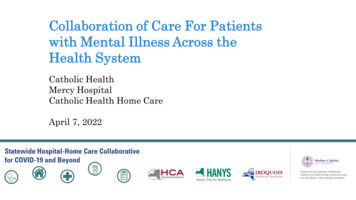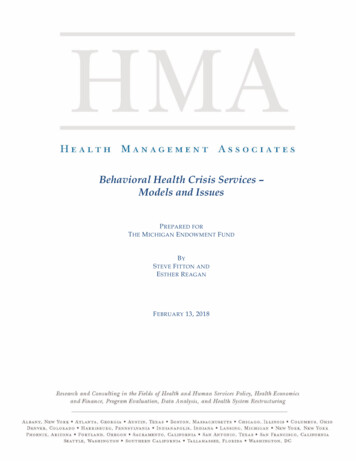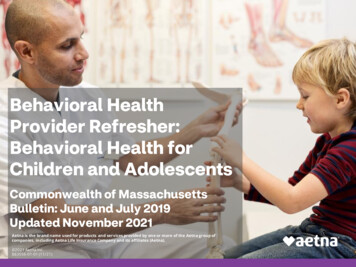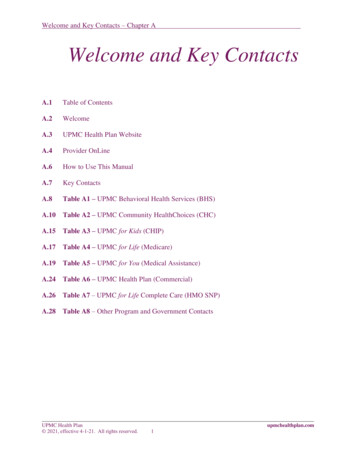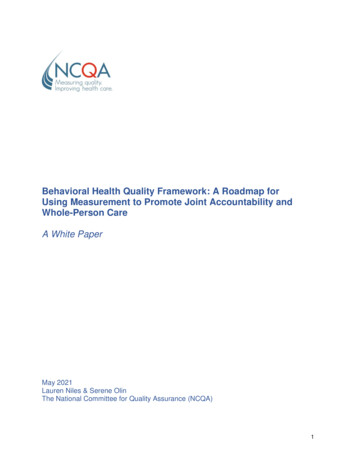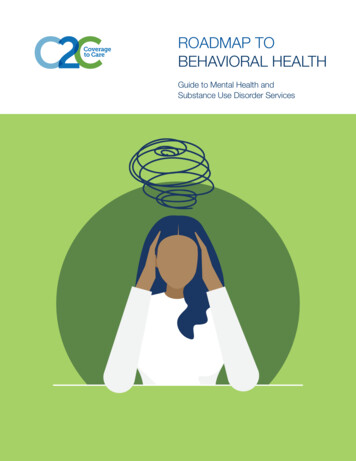
Transcription
ROADMAP TOBEHAVIORAL HEALTHGuide to Mental Health andSubstance Use Disorder Services
EMERGENCY AND CRISIS INFORMATIONNeed help now? Use these hotlines for help. If you are in acrisis, have an emergency, or a life-threatening situation,call 9-1-1 to go to an emergency department.If the situation is potentially life-threatening, get immediateemergency assistance by calling 9-1-1, available 24 hours a day.National Suicide Prevention K (8255) (TTY: 1-800-799-4889)is a 24-hour, toll-free, private suicide preventionhotline. Your call is routed to the nearest crisiscenter. On July 16, 2022, the National SuicidePrevention Hotline will transition to 988. Calls to988 will be directed to 1-800-273-TALK duringand after the 988 transition. Switching to aneasy-to-remember 988 as the ‘911’ for suicideprevention and mental health crisis services willmake it easier for those in crisis to access helpand decrease the stigma surrounding suicideand mental health issues.Veterans Crisis Lineveteranscrisisline.netCall 1-800-273-8255 select option 1(TTY: 1-800-799-4889), or text 838255. Thisline connects veterans in crisis to qualified, caringDepartment of Veterans Affairs (VA) respondersthrough a private, free hotline, chat, or text. Familyand friends of veterans may also use this service.Substance Abuse and Mental HealthServices Administration (SAMHSA)Treatment Locatorfindtreatment.samhsa.govSAMHSA Referral Helpline1-800-662-HELP (4357) (TTY: 1-800-487-4889)is a 24-hour free line that provides privatetreatment referrals. It can also give you informationabout mental and/or substance use disorders,prevention, and recovery. Calls are availablein English and Spanish. To find help nearby,send your zip code via text message: 435748(HELP4U).Disaster Distress lineCall or text 1-800-985-5990 if you’reexperiencing emotional distress fromnatural or human-caused disasters.Get immediate, multi-language, andprivate counseling.Coverage to CareRoadmap To Behavioral Health1
HOW TO USE THIS GUIDEUse this guide with the Roadmap to Better Careto understand how to use your health coverage toROADMAP TOBETTER CAREimprove your mental and physical health. This guideadds to the 8 steps of the Roadmap to Better Careto help you find out how to access behavioralhealth care.Medicare is health insurance for people65 or older. You’re first eligible to sign upfor Medicare three months before you turn 65.You may be eligible to get Medicare earlierif you qualify. Call 1-800-MEDICARE(1-800-633-4227) to learn more.41Maria’s story: Getting health insuranceIn November, during an Open Enrollment, Maria decides to apply for health insurance coverage. She knowsthat she can apply in a few ways. She looks for local help online at localhelp.healthcare.gov and finds anassister nearby. Maria makes an appointment to meet with Mark, an assister who can help her search throughMeet Mariaall the plans in her area.Maria finds her ID, proof of residence, and paystubs. She meets with Mark, who gives her an EnrollmentToolkit. This will help her learn why health coverage is important and what she needs to know beforeThe following fictional story, “Maria’s Story,” shows you how you canchoosing a plan. Mark explains to Maria how to apply for coverage, reviews the documents she provided,use this Roadmap. The story also provides an example of a real-lifeand helps her complete the application. Mark helps Maria determine if she qualifies for Medicaid, a programexperience to help you understand how to use your coverage tothat provides free or low-cost health coverage to low-income people and people with disabilities.address a behavioral health condition.Maria is choosing health insurance for the first time and is surprised by the number of choices. Mark explainswhat she should look at to find a plan that fits her budget and health needs. He helps her finish applying forcoverage. Maria’s insurance company will send her an insurance card and a member handbook after she paysher first premium.2Coverage to CareRoadmap To Behavioral Health3
CONTENTS1. Understand your behavioral health . . . . . . . . . . . . . . . . . . . . . . . . . . . . . . . . . . . 62. Learn about health insurance. . . . . . . . . . . . . . . . . . . . . . . . . . . . . . . . . . . . . . 133. Where to go for help and treatment. . . . . . . . . . . . . . . . . . . . . . . . . . . . . . . . . . 144. Find a behavioral health provider . . . . . . . . . . . . . . . . . . . . . . . . . . . . . . . . . . . 175. Make an appointment with a behavioral health provider . . . . . . . . . . . . . . . . . . . . . 206. Prepare for your appointment . . . . . . . . . . . . . . . . . . . . . . . . . . . . . . . . . . . . . 227. Decide if the behavioral health provider is right for you. . . . . . . . . . . . . . . . . . . . . . 258. Stay on the road to recovery. . . . . . . . . . . . . . . . . . . . . . . . . . . . . . . . . . . . . . 26Glossary. . . . . . . . . . . . . . . . . . . . . . . . . . . . . . . . . . . . . . . . . . . . . . . . . . . . 29Additional resources. . . . . . . . . . . . . . . . . . . . . . . . . . . . . . . . . . . . . . . . . . . . 32M y t o - d o l i st. . . . . . . . . . . . . . . . . . . . . . . . . . . . . . . . . . . . . . . . . . . . . . . . 354Coverage to CareRoadmap To Behavioral Health5
1. UNDERSTAND YOUR BEHAVIORAL HEALTH52.9MILLIONadults living in theU.S. with any mentalillness in 2020What is behavioral health?Behavioral health is a key part of your overall health. It includes your emotional, psychological, andsocial well-being and is just as important as your physical health.Behavioral health conditions include mental and substance use disorders. Mentaldisorders are changes in a person’s thinking, mood, and/or behavior. They can affect howthey relate to others and make choices. These types of disorders can only be diagnosed based onthe person’s ability to function as a result of their symptoms. Substance40.3MILLIONpeople in the U.S. ages 12and older with a substanceuse disorder in 2020use disorders occur when a person’s repeated use of alcohol and/or drugs, such asopioids, prescription drugs, heroin, and other illicit drugs, cause clinically-significant impairment.This may include health problems, disability, and failure to meet major responsibilities at home,school, or work. Co-occurring Co-existingdisorders are when a person has both a mental and substance use disorder.disorders means a person has both a behavioral health condition and a substanceuse disorder at the same time.Behavioral health conditions are common. People of all ages, genders, sexual orientations, races, and41.4MILLIONadults living in the U.S.who received treatment formental health in 2020ethnicities with any type of job, background, or income can have these conditions. These conditionscan happen to anyone, with or without physical disabilities. They are NOT due to their actions orphysical or mental capabilities.The COVID-19 pandemic has impacted almost all areas of our lives. This includes our behavioral health.Many of us have challenges or struggles that can be stressful and cause strong emotions. It’s naturalto feel stress, anxiety, grief, and worry during this time. However, if you’re struggling to cope, there aremany ways you can get help.If you notice changes in your mood or behavior, or if your alcohol or drug use causes problems, youmay want to talk to your doctor or health care provider. Behavioral health is part of your whole health.You should discuss it with your provider, family and friends. Help is available. Recovery is possible.6Coverage to CareRoadmap To Behavioral Health7
Behavioral health care usually starts witha screening, diagnosis, and includestreatment, recovery services, and support.ScreeningsScreenings can be as simple as a few questions. They are usually asked in a doctor’s office, medicalclinic, primary care clinic, community clinic, or (for youth) school-based clinic. They can help detectdisorders early and treat them before conditions get worse. If the screening finds a concern, a moredetailed assessment may be done for a diagnosis.TreatmentsTreatments include therapy or counseling, medication, and supportive services. They can help you findor maintain a job, education, and housing. Some treatments may include a hospital stay. It’s differentfor each person. Many people respond best to a combination of counseling, supportive services, andmedication treatments. Private medical information is never shared with family, employers, or othersregardless of the type of treatment.RecoveryRecovery services provide social and emotional support to help manage behavioral health conditions.They can also help with other concerns, like finding a job, childcare, or affordable housing. The recoveryprocess is different for each person. Servicesand support may be from a provider, support group, community clinic, place of worship,or other community organization. Family members, friends, caregivers, and social networks mayalso be a part of recovery. Peersare people who are in recovery with similar behavioral health conditions. They can help andshow you that recovery is possible.SupportPeer Support Services include assistance from people who share common life experiences withthose they serve. These services can include mentoring, coaching, building skills and help withnavigating the health care system.Detoxification is a process that safely clears out drugs or alcohol from the body. It can managewithdrawal symptoms when someone stops taking drugs or alcohol.8Coverage to CareRoadmap To Behavioral Health9
Everyone can experience the following feelingsand behaviors. Contact your doctor or specialtyprovider if you have one or more of them. Itcould be the sign of a serious problem.Maria’s story: Getting the right help to get betterIn January, Maria makes an appointment with her primary care provider for a check-up and to get preventiveservices. Her insurance plan covers these services for her with a 0 copayment.At her appointment, Maria tells her primary care provider that she hasn’t been sleeping or eating well for thepast couple weeks. She generally feels “down”, has low energy, and gets constant headaches. Sometimesshe’ll have a drink or two at night to relax and fall asleep. She’s also been very stressed at work lately. Maria’sprovider examines her and runs some tests but doesn’t find anything physically wrong with her. The providersuggests that Maria see a behavioral health provider who specializes in these concerns. Some primary care Eatingor sleeping too much or too littleclinics have a behavioral health provider onsite. However, since Maria’s does not, her provider gives her a list of Pullingaway from people and usual activitiesbehavioral health providers in her insurance network. Havinglow or no energy Feelingmore irritable or annoyed than usual, or all the time Havingunexplained aches and pains Feelinghelpless or hopeless Feelingsad, anxious, or “empty” Lossof interest or pleasure in hobbies and activities Feelingrestless or having trouble sitting still Difficultyconcentrating, remembering, or making decisions Smoking,drinking, or using drugs more than usual Feelingunusually confused, forgetful, on edge, angry, upset, worried, or scared Havingdeath or suicidal thoughts, or considering hurting yourself or others Beingunable to do daily tasks, such as taking care of your children or getting to work or schoolFor self-screening tools, tests, and more information, visit mentalhealth.gov & samhsa.gov.10Coverage to CareRoadmap To Behavioral Health11
2. LEARN ABOUT HEALTH INSURANCEWhat is health insurance?Health insurance helps pay for health care services like office visits, counseling, and prescriptionmedication.Health insurance protects you financially if something unexpected happens. It includes coverage forpreventive services and isn’t just for when you are sick or have an accident. It also helps you pay forservices to keep you healthy and manage your ongoing physical and behavioral health conditions.To learn more about coverage terms, like premium, copay, and deductible, see the Roadmap to BetterCare or the glossary at the end of this guide. If you need help on how to enroll, visit healthcare.gov orcall the Marketplace Call Center at 1-800-318-2596. You can also call 1-800-Medicare or contact yourstate Medicaid office.What does health insurance include?Many health plans must cover certain health benefits. This includes mental health and substance usedisorder services. Your exact benefits depend on your state and the type of plan you choose.These mental health and substance use disorder services are usually covered under most health plans: AccessDo you have no health insurance?If you don’t have health coverage, visit healthcare.gov to learn aboutenrollment periods and other information you need to get coverage. If youneed help on how to enroll, visit healthcare.gov, or call the MarketplaceCall Center at 1-800-318-2596. You can find local help at localhelp.healthcare.gov.You can find a nearby provider or clinic that offers low-cost or free servicesthrough the SAMHSA Treatment Locator at findtreatment.gov, or theHRSA Health Center Program Finder at findahealthcenter.hrsa.gov.12to behavioral health providers such as psychiatrists, psychologists, social workers, andadvanced practice registered nurses; Treatments, like psychotherapy, counseling, medication, and detoxification of substances used;Inpatient services, such as a hospital or emergency room (ER) visit; Pre-existing Preventiveconditions; andservices, like alcohol and depression screenings.By law, many health plans have similar coverage rules for mental health and substance use disorderservices. The same is true for medical and surgical services. This is called “mental health parity” or “parity”.If your plan offers parity, and you receive unlimited doctor visits for a chronic condition, like diabetes, theymust also provide unlimited visits for a mental health condition, like depression.Coverage to CareRoadmap To Behavioral Health13
3. WHERE TO GO FOR HELP AND TREATMENTSometimes it’s difficult to talk about mental health or substance use concerns. However, this is a normalconversation you can have with a health care provider who respects your privacy.You can find a behavioral health care provider in many different ways and places. This can include aprimary care provider, behavioral health provider in outpatient clinics, or in urgent cases, the emergencyIf the situation is potentiallylife-threatening, getimmediate emergencyassistance by calling 9-1-1,available 24 hours a day.department (ED) of a hospital.You will usually see a primary care provider first. They can provide recommended screenings and referyou to a behavioral health provider.Behavioral health providers are specially trained to provide health care services to people with mentaland substance use problems. They may work in different locations. This may include: hospitals, community mental health clinics, substance use treatment centers, primary care clinics, school-based health centers, college counseling centers, and private practices.Primary care and behavioral health providers can work in the same building, or part of the same clinic,hospital, or health center. You may receive all your care in one location or through telehealth.Visits to your primary care provider are different from visits to the ED or ER of a hospital in many ways,such as cost, time you wait for care, and follow-up. If you need to go to the hospital but cannot affordit, your insurance provider or the hospital may be able to help with payment.Review the table in the Roadmap to Better Care to learn how visits to your primary care provider aredifferent from visits to the ED of a hospital.If you’re in a potentially life-threatening situation, you should call 9-1-1, available 24/7, forimmediate emergency assistance. You can also contact your provider or one of the helplines listedat the front of this book.14Coverage to CareRoadmap To Behavioral Health15
4. FIND A BEHAVIORAL HEALTH PROVIDERIt’s important to find the right behavioral health care provider for you. You can find one in many ways: Primarycare providers are doctors, nurse practitioners, or other health care providers. They maybe able to screen or treat you for behavioral health problems. A primarycare provider may also recommend or refer you to a behavioral health provider. You mayneed a referral for your health plan to pay for a visit. Check with your health plan or call the behavioralhealth provider’s office to see if they are an in-network provider and accept your insurance. Checkyour health plan directory: — Call your health plan or state Medicaid and Children’s Health Insurance Program (CHIP); — Check your health plan’s website or member handbook to find local behavioral health providers.You may want to confirm that their information is up-to-date. — Use the plan directory to search for specific needs. It may also indicate who speaks a languageother than English and can accommodate mobility challenges, if it is located near you, or if itworks with specific populations, such as veterans. Askyour family, friends, and people in your community for recommendations.A network is a group of facilities, providers, and suppliers that has an agreement with your health plan toprovide you with health care services. ContactA network is a group of facilities,providers, and suppliers that has anagreement with your health plan toprovide you with health care services.16your health plan to find providers who are “in-network”. Your plan may refer to them as“preferred” or “participating” providers. Yourplan may not cover, or you may pay more, for services from a provider who is “out-of-network.” Networkscan change, so you should always check with your provider when you make anappointment with them.Coverage to CareRoadmap To Behavioral Health17
Types of Behavioral Health ProvidersThere are many types of behavioral health providers. Contact your primary care provider if you needhelp finding the right type of provider for you.Some examples include: Psychiatristsare physicians who diagnose mental and substance use disorders, prescribe andmonitor medications. They may also provide counseling and talk therapy. Psychiatricor Mental Health Nurse Practitioners provide assessment, diagnosis, and therapy formental or substance use disorders. They are trained nurses and can also prescribe medication. Yourstate may refer to them as: — Advanced Registered Nurse Practitioner, — Advanced Practice Registered Nurse, — Advanced Practice Nurse, — Certified Nurse Practitioner, — Certified Registered Nurse Practitioner, or — Licensed Nurse Practitioner ClinicalPsychologists make diagnoses and provide counseling and therapy services. Some statesallow them to prescribe medications. Clinical Social Workers provide counseling and therapy services, case management, andadvocacy. They also make diagnoses. SocialWorkers manage cases and help people locate treatment and other services that supporttheir recovery, health and well-being. Counselorsmake diagnoses and provide counseling services. They help people improve life skills andrelationships. PeerSpecialists/Recovery Coaches help and teach people in recovery about the health system,and provide emotional and social support. Peers are also in recovery and have had mental orsubstance use disorders. They often receive training and certification. Substance/Addiction Counselors provide treatment and support services to people with alcoholor other substance use disorders. They help and advise them in their recovery.18Coverage to CareRoadmap To Behavioral Health19
5. MAKE AN APPOINTMENT WITH ABEHAVIORAL HEALTH PROVIDERMaria’s story: Getting a behavioral health providerMaria returns home from meeting with her primary care provider. She reviews her health plan’s behavioralhealth provider directory but does not know where to start. Her friend suggests that she first look forAfter you choose a behavioral health provider, make an appointment with them.When you call to schedule your appointment, you should ask: Dothey accept new patients? Dothey accept your insurance? Always double check! If they ask you to provide yourproviders who are closest to where she lives. She finds helpful information online and calls a few provideroffices to see if they accept her insurance and take new patients. Maria contacts a provider, Dr. Lee, aclinical psychologist, who is friendly and located in a good location for her. Dr. Lee takes new patients andalso accepts Maria’s insurance, so she schedules an appointment.Member ID and/or group number, you can find it on your insurance card. Before yourappointment, find out how much your copay or out-of-pocket expenses may cost. What Howmental health and substance use conditions does the provider treat?soon can you schedule an appointment with the provider? Doesthe provider speak your language? If not, do they have an interpreter or can theyhelp you find one? Can you bring a family member or friend with you to the appointment? If youhave limited mobility or other disabilities, can the office meet your needs?You may also want think about: Howwill you travel to the appointment? Is the office near your home or place of work? Is public transportation nearby? Does the provider offer telehealth services so you can get care from home? Do the appointment times available work with your schedule?For more information, refer to Step 5 (“Make an appointment”) in the Roadmap to Better Care.Many providers offer behavioral health care through telehealth. This could include mental healthcounseling, follow-up on care plans, and services for substance use disorders. Most healthplans cover behavioral health services similar to physical health services. For more information,refer to Telehealth: What to Know for Your Family.20Coverage to CareRoadmap To Behavioral Health21
6. PREPARE FOR YOUR APPOINTMENTAfter you schedule your appointment, it’s time to prepare. Bring these items with you toyour appointment:nYour insurance cardnValid photo IDnnPersonal or family health historyList of allergiesMaria’s story: Getting and keeping behavioralhealth careIn February, Maria goes to her first appointment with Dr. Lee, a clinical psychologist. She brings herinsurance card, photo ID, copay, and checks in with the receptionist. The receptionist asks Maria to fillout some forms. Maria is a little nervous, but she feels better when Dr. Lee smiles and warmly greetsher in the waiting room. She leads Maria to her office and closes the door.Dr. Lee tells Maria that their conversation is generally private, but subject to very rare exceptions that maybe permitted under state law. Dr. Lee also tells Maria about other services their office provides, like grouptherapy. Dr. Lee asks Maria some questions: Why are you here? What do you want to accomplish?Maria mentions her symptoms and job-related stress. Dr. Lee listens to her carefully and asks morequestions. At the end of the session, Dr. Lee suggests that Maria return and schedule a follow-upappointment. She also recommends that Maria keep a journal on how she feels about her job, hown Any medications, vitamins, or supplements that you currently take— Bring them or make a list of their names, who prescribed them, and how much you take each daynList of other providers you have seenwell she sleeps, and how many alcoholic drinks she consumes each day. Maria agrees with Dr. Lee’srecommendations and schedules another appointment.Afterwards, Maria thinks about her visit with Dr. Lee and feels good about it. She thinks Dr. Lee will be agood provider for her because she felt comfortable. Maria is looking forward to her next appointment.n Notes to write down:— Questions you want to ask your provider— Any symptoms you currently have, how long you’ve had them, and how they impact your life— Bring a notepad to write down any instructions the provider gives youn Payment for a copayment or coinsurance (if your insurance requires it)Bring anything else the provider may need to answer your questions and address your concerns. It’simportant that you feel comfortable with any information or instructions they give you. You may want tobring a family member or friend with you for support. Ask the provider’s office if you can bring a guest toyour appointment.22Coverage to CareRoadmap To Behavioral Health23
7. DECIDE IF THE BEHAVIORAL HEALTHPROVIDER IS RIGHT FOR YOUYour health and well-being are both important and personal. You should trust and feel comfortableworking and talking with your behavioral health provider. It’s also important for your providerto share and help you make decisions about your treatment. You should feel comfortable withthe treatment plan and that it will fit your needs. Discuss any concerns or questions about yourtreatment with your provider.Trusting and working with your provider will help you feel and stay better. Trust is built over timethrough repeat appointments and open communication.After your first visit, think about: Didthe provider listen to you and address your health needs? Didthe provider use words that you could understand? Did he/she speak slowly enough andpay attention to you? Did he/she speak in a way that made you feel comfortable? Didthe provider clearly explain your treatment options and their benefits and risks? Did you talkabout a treatment plan? Do you feel that you shared in this decision? If youwere given a prescription, did the provider tell you more about it? Such as, when shouldyou take the medicine? How much should you take? Are there any potential side effects? Didthe provider respect your culture, opinions, values, and beliefs? Do you feel comfortablecoming back for another appointment? If youasked the provider for assistance; for example, an interpreter, translation, other form ofwritten material, or assistance related to your disability, did they provide it? Doyou have a follow-up plan? Canyou contact your provider or their staff with questions? Are there other health careproviders they should contact to coordinate care?If you answered “Yes” to most of these questions, then you may have found a behavioralhealth provider that’s right for you!If you answered “No” to any of these questions, call the office and share your concerns with them.They may be able to address or resolve them easily. You can also request to see another providerin that practice. Or, you can contact your health plan to find a new provider.24Coverage to CareRoadmap To Behavioral Health25
8. STAY ON THE ROAD TO RECOVERYYour treatment plan is important. After your appointment:1. Schedule any follow-up appointments before you leave. Routine appointments thatwork well with your schedule can help build trust and a solid partnership with your provider.2. Follow the treatment plan that you and your provider agree on. If you’re confusedabout your plan or don’t know how to follow it, see Step 8 (“Next steps after yourappointment”) of the Roadmap to Better Care for some helpful tips.3. Read your Explanation of Benefits (EOB). An EOB is a summary of health care charges.Your health plan will send it to you after you visit a provider or receive a service. It’s not abill. It’s a record of your services that includes the amount your provider charged your healthplan, how much you should expect to pay, and anything that hasn’t been paid. You mayreceive a bill later if you had a copay or any coinsurance that your plan did not cover.4. Be sure you are covered with the right plan. Plans and your health needs can change.Review your coverage options during each Open Enrollment to make sure your plan meetsyour needs. You could be eligible for a special enrollment period if you move, get married,have a baby, or lose your previous coverage. Also, if you qualify for Medicaid, you can enrollMaria’s story: Getting to recoveryat any time. Review the Enrollment Toolkit to find out how to enroll in a health plan.5. Access care management resources and talk to your provider. Chronic caremanagement (CCM) services can help you spend less time managing your care and moretime doing what you love. Talk to your provider about any side effects or other concernsabout your medication before you decide to stop taking it. You may need to change yourmedication to find one that works for you.Maria prepares for her next appointment with Dr. Lee. She brings the journal they agreed that she wouldkeep. Maria also brings a list of family, friends, and loved ones who support her. She decides to rideher bike to the appointment even though she’s tired. At her first appointment, Dr. Lee said exercise isimportant and helps keep her body and mind healthy.At their appointment, Maria and Dr. Lee discuss her journal and list of people in her life who support her.They talk about Maria’s job and how it could be causing her stress. Dr. Lee recommends some changesthat Maria can do to help reduce her stress.Maria sees Dr. Lee once a week for the next three months. According to her health plan, Maria will onlyneed to pay a copay for her visits with Dr. Lee. After three months, Maria notices that she’s sleepingbetter, eating more regularly, and no longer has headaches. She also feels more energetic and is moreinterested in activities outside of her job. Maria and Dr. Lee will discuss a revised treatment plan basedon he
What is behavioral health? Behavioral health is a key part of your overall health. It includes your emotional, psychological, and . social well-being and is just as important as your physical health. Behavioral health conditions include mental and substance use disorders. Mental disorders. are changes in a person's thinking, mood, and/or .

